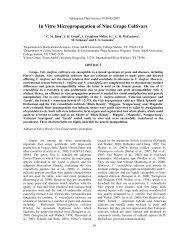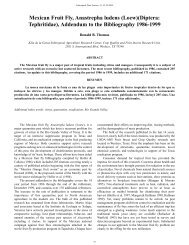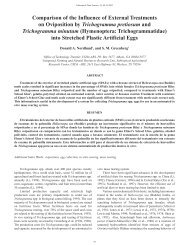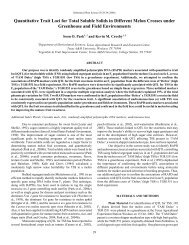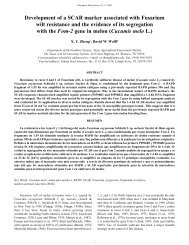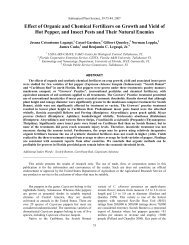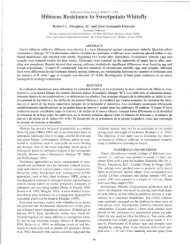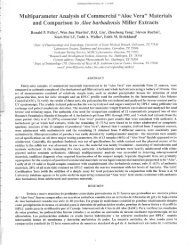Jian-Long Bi and Nick C. Toscano - Subtropical Plant Science Society
Jian-Long Bi and Nick C. Toscano - Subtropical Plant Science Society
Jian-Long Bi and Nick C. Toscano - Subtropical Plant Science Society
Create successful ePaper yourself
Turn your PDF publications into a flip-book with our unique Google optimized e-Paper software.
<strong>Subtropical</strong> <strong>Plant</strong> <strong>Science</strong>. 57:1-4. 2005<br />
MATERIALS AND METHODS<br />
Insects <strong>and</strong> insecticides. Beet armyworm used in the<br />
bioassay was from a susceptible colony collected from Orange<br />
County, California, <strong>and</strong> was maintained at the University of<br />
California at Riverside. The colony was subjected to periodic<br />
infusion of wild insects. Larvae were maintained on an artificial<br />
diet as described by Patana (1985). Insecticides used in the<br />
experiment were as follows: bifenthrin (FMC, Philadelphia, PA),<br />
methomyl (DuPont, Wilmington, DE), emamectin benzoate<br />
(Syngenta, Greensboro, NC), <strong>and</strong> chlorfenapyr (Olympic Hort.<br />
Products, Mainl<strong>and</strong>, PA). These chemicals were diluted in acetone<br />
for different concentrations.<br />
<strong>Bi</strong>oassays. Third instar larval <strong>and</strong> adult male beet<br />
armyworm were used to test the toxicity of the insecticides. The<br />
mean larval weight was 7.5 mg <strong>and</strong> the mean weight of adults was<br />
37.0 mg. There were no significant differences among initial<br />
weights of the larvae or adults used in the experiment (P < 0.05).<br />
For test purposes, 0.5 μl <strong>and</strong> 1 μl of each concentration of diluted<br />
insecticides or acetone control were delivered to the thoracic<br />
dorsum of larva <strong>and</strong> adult, respectively, with an Arnold<br />
microapplicator (Burkard, Rickmansworth, Engl<strong>and</strong>). The<br />
concentrations (μg AI/μl) of each insecticide used in the test<br />
against larvae were as follows, methomyl: 0.212, 0.425, 0.850,<br />
1.700, 3.400, 6.800, <strong>and</strong> 13.600; bifenthrin: 0.003, 0.006, 0.0120,<br />
0.024, 0.048, 0.080, <strong>and</strong> 0.100; ememectin benzoate: 0.002, 0.005,<br />
0.010, 0.02, 0.050, <strong>and</strong> 0.080; chlorphenapyr: 0.100,0.200, 0.400,<br />
0.800, 1.200, 1.600, 2.400, <strong>and</strong> 4.800. The concentrations (μg<br />
AI/μl) of each insecticide used in the test against adults<br />
were:methomyl, 0.026, 0.053, 0.160, 0.212, 0.320, <strong>and</strong> 0.425;<br />
bifenthrin, 0.010, 0.0125, 0.020, 0.030, 0.040, <strong>and</strong> 0.050;<br />
emamectin benzoate, 0.08, 0.160, 0.320, 0.640, 1.280, 2.560, <strong>and</strong><br />
5.120; chlorfenapyr, 0.200, 0.400, 0.800, 1.600, 2.400, 4.800, <strong>and</strong><br />
9.600. Those concentrations of each insecticide covered 5-95%<br />
mortality of the tested insects. A minimum of twenty larvae or<br />
adults was treated with each concentration of each insecticide.<br />
Each larva was held in a 30-ml plastic cup filled with artificial diet.<br />
Beet armyworm adults were incubated in groups of 10 moths per<br />
oviposition cage with 10% sugar solution for nourishment.<br />
Mortality of insects for each dosage of the insecticides was<br />
recorded at 24 h intervals up to 96 h after application. Insects were<br />
considered dead if they did not move when prodded with a<br />
dissecting needle.<br />
Data analysis. The resulting data were corrected for<br />
control mortality (Abbott, 1925) <strong>and</strong> analyzed by probit analysis<br />
using POLO-PC (LeOra Software 1987). LD 50 <strong>and</strong> LD 90 for each<br />
insecticide were determined for each 24 h interval (24, 48, 72, 96<br />
h) after the treatment. Differences in LD 50s <strong>and</strong> LD 90s were<br />
considered significantly different if their respective 95% CL did not<br />
overlap.<br />
Table 1. Toxicity of selected insecticides to beet armyworm third instar larvae.<br />
Insecticides<br />
Hours after<br />
application n Slope ± SE<br />
a<br />
LD 50<br />
(95% CL)<br />
a<br />
LD 90<br />
(95% CL)<br />
Methomyl 24 275 1.04 ± 0.16 53.33 a<br />
(19.27-93.05)<br />
904.38 a<br />
(404.49-6724.87)<br />
48 275 1.12 ± 0.17 42.14 a<br />
(17.50-69.76)<br />
581.73 a<br />
(308.82-2125.37)<br />
72 275 1.06 ± 0.17 31.34 a<br />
(10.35-55.52)<br />
512.40 a<br />
(268.15-1997.42)<br />
96 275 1.07 ± 0.17 29.21 a<br />
(7.90-54.46)<br />
466.19 a<br />
(237.57-2092.69)<br />
<strong>Bi</strong>fenthrin 24 250 1.50 ± 0.24 0.64 a<br />
(0.40-0.89)<br />
3.74 a<br />
(2.66-14.20)<br />
48 250 1.57 ± 0.24 0.57 a<br />
(0.33-0.81)<br />
3.74 a<br />
(2.23-11.62)<br />
72 250 1.71 ± 0.25 0.56 a<br />
(0.33-0.79)<br />
3.13 a<br />
(1.94-8.68)<br />
96 250 1.71 ± 0.25 0.56 a<br />
(0.33-0.79)<br />
3.13 a<br />
(1.94-8.68)<br />
Emamectin<br />
benzoate<br />
24 275 1.56 ± 0.18 0.91 a<br />
(0.53-1.60)<br />
6.05 a<br />
(2.90-35.92)<br />
48 275 1.59 ± 0.19 0.36 b<br />
(0.22-0.52)<br />
2.29 ab<br />
(1.45-5.00)<br />
72 275 1.62 ± 0.20 0.24 b<br />
(0.14-0.33)<br />
1.45 b<br />
(0.98-2.64)<br />
96 275 1.97 ± 0.24 0.19 b<br />
(0.07-0.31)<br />
0.85 b<br />
(0.51-2.37)<br />
Chlorfenapyr 24 275 1.57 ± 0.20 24.64 a<br />
(14.57-36.68)<br />
160.65 a<br />
(91.36-522.15)<br />
48 275 1.92 ± 0.21 18.93 a<br />
(10.58-28.15)<br />
88.14 a<br />
(55.34-214.04)<br />
72 275 2.07 ± 0.22 17.92 a<br />
(11.13-25.24)<br />
74.48 a<br />
(50.33-144.11)<br />
96 275 2.15 ± 0.23 17.58 a<br />
(11.06-24.58)<br />
69.28 a<br />
(47.47-129.19)<br />
a μg AI g -1 larva body weight, column values within an insecticide <strong>and</strong> a lethal concentration followed<br />
by different letters are significantly different (non-overlap of 95% CL).<br />
2



